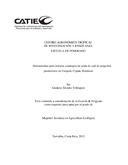| dc.contributor.advisor | Siles, Pablo | |
| dc.contributor.author | Alvarez Velásquez, Gustavo | |
| dc.date.accessioned | 2014-10-20T05:07:47Z | |
| dc.date.available | 2014-10-20T05:07:47Z | |
| dc.date.issued | 2012 | es_ES |
| dc.identifier | 387478 | es_ES |
| dc.identifier.uri | https://repositorio.catie.ac.cr/handle/11554/5183 | |
| dc.description | Tesis (Mag. Sc) -- CATIE, Turrialba (Costa Rica), 2012 | es_ES |
| dc.description.abstract | El estudio se realizo en el Departamento de Copán, en el Municipio de Corquín, donde se seleccionaron 6 fincas de pequeños productores. Una vez identificadas las 6 fincas se hizo una estimación de cosecha 2010-2011. Luego se desarrollaron talleres para modificar la metodología de diagnostico productivo con grupos focales técnicos y productores. En cada finca se hicieron diagnósticos productivos. Luego se hizo una categorización de plantas en las 6 fincas, con las categorías formadas por los técnicos y productores. Se estableció un ensayo de podas en cada finca experimental y terminando con una segunda estimación de cosecha 2011-2012. Después del cuarto año de producción en la planta de café, la práctica de podas es la forma más aconsejable de recuperar el nivel productivo y evitar la bi-anualidad del cultivo. El manejo de podas consiste en eliminar los tejidos agotados e improductivos de las plantas haciendo diferentes tipos y técnicas de podas. | es_ES |
| dc.description.abstract | This study was conducted on 6 smallholder farms in Corquín, Copan, and western Honduras. First, workshops were organized with producers and technicians to modify the methodology to evaluate production. Second, in each farm, an estimate of coffee production was made for the 2010-2011 harvest. Technicians and producers then organized the coffee trees on the plantation into different categories: plants in high production (PAP), plants in low production (PP) and plants not in production (PNP). A trial of coffee tree prunings was established in each of the six experimental farms with the following pruning techniques: topping, complete cutback, pruning of new shoots, no pruning, high-level pruning, medium-level pruning. An estimate of the harvest for each of the farms was then made for the 2011-2012 harvest. After the fourth year of production in the coffee plantation, coffee tree pruning is the most recommended means to recover the levels of production on the farm and mitigate the biannual nature of the plants' fruiting. Prunings of the coffee plantation are designed to eliminate unproductive tissues. There are a variety of different types/techniques of prunings for the coffee plantation. | |
| dc.language.iso | es | es_ES |
| dc.publisher | CATIE, Turrialba (Costa Rica) | es_ES |
| dc.relation.ispartof | Magister Scientiae en Agricultura Ecológica | |
| dc.subject | COFFEA ARABICA | |
| dc.subject | PODA | |
| dc.subject | TIPOS DE PODA | |
| dc.subject | MANEJO DEL CULTIVO | |
| dc.subject | PARCELAS | |
| dc.subject | PRODUCTIVIDAD | |
| dc.subject | PEQUEÑO AGRICULTOR | |
| dc.title | Herramientas para orientar estrategias de poda de café de pequeños productores en Corquín, Copán, Honduras | es_ES |
| dc.title.alternative | Tools to orient six smallholder farmers in strategies for pruning coffee trees on their plantations, Corquin, Copan, Honduras | es_ES |
| dc.type | Tesis de maestría | es_ES |
| dcterms.rights | acceso abierto | es_ES |
| dc.identifier.publication | Turrialba (Costa Rica) | es_ES |


